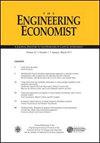平滑模糊条件下的期限结构和基于情景的社会折现率
IF 1.2
4区 经济学
Q4 BUSINESS
引用次数: 0
摘要
摘要许多研究基于拉姆齐规则来估计社会折现率。为了反映决策者对风险和不确定性的态度,该规则以各种方式进行了扩充。本文采用Ju和Miao的模糊递推效用,利用效用梯度法建立了一个通用的社会折现率公式。导出的公式使我们能够获得风险厌恶、跨期替代和歧义厌恶的三元显式分离,如Traeger中所述。它也超越了经典的两阶段设置,从而可以研究模糊条件下社会折现率的期限结构。由于这种方法的普遍性,我们可以直接应用气候变化下众所周知的增长情景,从而得出基于情景的社会折现率,这可以作为评估气候变化政策或相关项目的实践指南。本文章由计算机程序翻译,如有差异,请以英文原文为准。
Term structures and scenario-based social discount rates under smooth ambiguity
Abstract Many studies estimate social discount rates based on the Ramsey rule. The rule has been augmented in various ways in order to reflect the decision maker’s attitude toward risk and uncertainty. In this article, we adopt the recursive utility with ambiguity of Ju and Miao and develop a general social discount rate formula via the utility gradient method. The derived formula allows us to obtain the three-way explicit separation of risk aversion, intertemporal substitution, and ambiguity aversion as in Traeger. It also goes beyond the classical two-period setting and thus term structures of social discount rates under ambiguity can be studied. Due to the generality of this approach, we can directly apply the well-known growth scenarios under climate change so as to derive scenario-based social discount rates, which can be used as a guide in practice to assess climate change policies or related projects.
求助全文
通过发布文献求助,成功后即可免费获取论文全文。
去求助
来源期刊

Engineering Economist
ENGINEERING, INDUSTRIAL-OPERATIONS RESEARCH & MANAGEMENT SCIENCE
CiteScore
2.00
自引率
0.00%
发文量
14
审稿时长
>12 weeks
期刊介绍:
The Engineering Economist is a refereed journal published jointly by the Engineering Economy Division of the American Society of Engineering Education (ASEE) and the Institute of Industrial and Systems Engineers (IISE). The journal publishes articles, case studies, surveys, and book and software reviews that represent original research, current practice, and teaching involving problems of capital investment.
The journal seeks submissions in a number of areas, including, but not limited to: capital investment analysis, financial risk management, cost estimation and accounting, cost of capital, design economics, economic decision analysis, engineering economy education, research and development, and the analysis of public policy when it is relevant to the economic investment decisions made by engineers and technology managers.
 求助内容:
求助内容: 应助结果提醒方式:
应助结果提醒方式:


